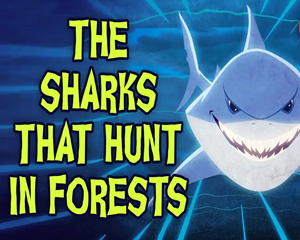In the coastal waters of the Bahamas, a young lemon shark is on the run from a surprising predator: an adult shark of her own species.
在巴哈马沿海水域,一条幼年柠檬鲨正在躲避一个令人意外的捕猎者:一条成年的柠檬鲨。
Half of her 17 siblings have already been eaten by the older generation, and it looks as though she's about to join them.
她17个兄弟姐妹中的半数已经被前辈吞食,而现在似乎它也即将加入它们的行列。
But just as the predator closes in, she disappears into a thicket of underwater roots, safe in the refuge of the mangrove forest.
但正当捕食者逼近之时,它消失于一片茂密的水下根茎之中,安全地藏于红树林的庇护之中。
Forests don't usually come to mind as a habitat for sharks.
几乎没有人会把森林和鲨鱼的栖息地联想起来。
But various marine forests cover roughly 4.2 million square kilometers of the planet, providing food and shelter for 35% of the world's sharks.
但多种海上森林覆盖了这座星球,约420万平方公里的面积,为世界上35%的鲨鱼提供食物和栖息地。
Deadly tiger sharks blend into seagrass meadows before pouncing on sea cows and sea turtles.
致命的虎鲨们在猛扑向海牛和海龟之前埋伏在海草丛中。
White sharks hunt down seals in forests of kelp towering 65 meters tall.
白鲨在高达65米的海带林里狩猎海豹。
And lemon sharks stalk forests of mangroves -- the only trees on Earth that live in the ocean.
而柠檬鲨则穿梭在红树林中--地球上唯一活在海里的树。
All these ecosystems have their quirks, but mangroves may be the most unique of all.
所有这些生态系统都有着自己的神奇之处,但是红树林可能是最独特的。
Harboring life between their roots and among their crowns, mangroves function as an essential bridge between land and sea.
它们的树根与树冠为生命提供庇护,红树林行使着衔接海陆的重要桥梁的功能。
And to survive between these worlds, different mangrove species have evolved various adaptations that protect them and their resident sharks.
而为了在这些世界里生存,不同种类的红树林进化出了多种保护它们本身和寄宿鲨鱼们的适应特性。
Taking root in the unstable ground of muddy coastal regions is difficult, so mangrove seedlings germinate attached to their mother plant.
在泥泞的海岸地区中不稳定的大地上扎根是困难的,因此红树幼苗缠在红树妈妈上发芽。
Once they've grown large enough to survive on their own, these partially developed plants begin to ride the current.
在它们长大到能够独自生存时,这些部分发育过的植物开始随浪漂流。
Most take root nearby, while some travel for several months before landing in a different part of the world.
大多数在附近扎根,而有些则漂流数月直到到达世界不同的角落。
Once they've settled down, mangroves deploy tall, skinny stilt roots, crutch-like prop roots or wavy buttress roots, to support themselves in their unsteady terrain.
在它们安定下来后,红树们长出高大、细长的高跷根,形似拐杖的支柱根,或者弯曲的扶壁根,以在不稳的地形中支撑它们自己。
These newly established mangroves have to contend with two additional problems:
这些新长成的红树林需要与额外两个问题斗争:
seawater is high in dehydrating and potentially toxic salt, and the mud contains little to no oxygen.
海水富含会导致脱水甚至可能具有毒性的盐类,且泥地含有过少或完全不含氧。
This combination would be lethal to most trees, but mangroves make the most of their marshy surroundings.
这两个问题合在一起对大多树木来讲会是致命的,但是红树林充分利用它们泥泞的环境。
Rather than being completely buried, mangrove roots are largely above the ground.
相比完全埋在地下,红树根大部分位于地表之上。
This allows the microscopic pores on these roots to take in oxygen during low tide before closing to create a waterproof seal during high tide.
这允许这些树根上的微小气孔在低潮时能吸入氧气并在涨潮前关闭以防止水分进入。

Many mangroves also grow snorkel roots, which can take in oxygen through the same mechanism, or directly produce it via photosynthesis.
很多红树还长有通气根,它们能通过相同原理来吸入氧气,抑或使用光合作用来直接产氧。
To stop salt from entering their system, some mangrove species use incredibly fine filters in their roots.
为了阻止盐分进入它们的系统,有些红树种类使用它们根部中极细的过滤器。
Others concentrate salt inside special cellular compartments, bark or dying leaves, that then drop off.
其它的则将盐浓缩到特殊的细胞室、树皮或将枯萎并掉落的树叶里。
Some species can even excrete the excess minerals through specially adapted salt glands.
有些品种甚至能通过特别进化的盐腺排出多余的矿物质。
All these processes make mangroves more than a little salty, but that doesn't deter coastal life from living in their nooks and crannies.
所有这些过程把红树林变得咸咸的,但这并不阻止海岸生物在它们的角落和缝隙里生活。
While birds nest among mangrove branches, fish lay eggs amidst their sprawling, complex root systems.
鸟儿们在红树枝间筑巢,鱼儿们在它错综复杂的根系间产卵。
Symbiotic sponges and sea squirts protect their host trees from hungry woodboring crustaceans.
共生海绵和海乌贼保护它们的宿主树免受饥饿且爱钻木头的甲壳动物伤害。
Crabs, snails, and shrimp eat algae, mussels, barnacles, and salty mangrove detritus.
螃蟹、螺、虾,吃海藻、青口贝、藤壶还有咸咸的红树残渣。
These animals in turn feed fish, which are devoured by shark pups roaming the roots -- alongside occasional vegetarian meals of seagrass.
这些小动物则喂饱鱼类,后者被在树根间游荡的鲨鱼幼崽吞食--鲨鱼们有时还吃海草素食餐。
But sharks aren't just the beneficiaries of marine forests, they're part of the glue that holds them together.
但鲨鱼不是海中林的唯一受益者,它们也是保持红树林生态的重要“粘合剂”之一。
Sharks limit the abundance of animals which would otherwise overgraze these essential plants.
鲨鱼限制动物的数量,否则太多的动物会过度消耗这些重要植物。
Just as marine forests provide shelter to vulnerable baby predators, those predators grow up to protect their forest homes.
就像海中林为脆弱的猎食动物宝宝提供庇护所,这些猎食者长大后保护它们的森林之家。
Unfortunately, both sides of this delicate balance are under threat.
不幸的是,这精妙平衡的双方都正遭受威胁。
Overfishing has decimated shark populations worldwide, and many marine forests are being polluted or cut down for coastal development.
过度捕鱼在世界范围大幅减少了鲨鱼数量,并且很多海中林正在因为沿海开发而被砍伐和污染。
This destruction is especially dangerous because marine forests are one of the single most important ecosystems in mitigating climate change.
这些破坏特别危险,因为海中林对于减轻环境变化来说,是最重要的生态系统。
Mangroves and seagrasses trap carbon between their roots, and fast-growing kelps export vast amounts of carbon to the deep ocean.
红树林和海草林在根系中困住碳,而长得飞快的海带将大量碳输出到深海区域。
Together, marine forests sequester around 310 million tonnes of carbon every year, capturing 3% of our annual global carbon emissions.
算在一起,海中林每年将大约310万吨碳隔绝起来,捕获我们每年全球碳排放的百分之三。
So, like the sharks that inhabit them, humans need to fight tooth and nail to protect these essential ecosystems.
所以,就像栖息在它们中的鲨鱼,人类需要极尽全力来保护这些重要的生态系统。













